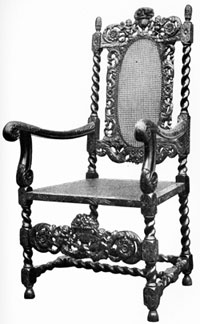Beauty in Design - 4th Test of Excellence
The fourth test of excellence in a design is the test of beauty. Beauty in a rug, a table or a textile is like beauty in the room as a unit in that it is beyond definition and beyond convincing analysis. It is, however, dependent upon unity in diversity, graceful and rhythmic line, good proportion, symmetry, and pleasing color. There is, of course, this obvious distinction: that the rug or the table or the velvet are but parts of the whole treatment, and as such may properly lack elements of beauty which are supplied by other parts of the whole. Thus a plain rug, like a plain paper or a plain taffeta, though it lack variety both in pattern and coloring, may be beautiful in a room where its plainness is required to set off the rich diversity of other decorative elements.
The best way to learn to recognize beauty in a design is to observe and compare designs, of whatever sort and wherever they are to be seen; whether in the home, the shop or the museum. The next best way, and a way open to all of us, whatever our situation, is to study illustrations of designs in books and magazines. It makes no difference that many of the designs we see are bad, so long as we see large numbers of examples, and study them carefully and impartially, for the eye and the mind quickly acquire through practice and discipline the power to discriminate between bad and good. In fact we learn to know the good more quickly through comparison with the bad.
It is important to note that the student will profit most largely from the observation and study of individual designs, rather than from groups made up of many diverse units. When the layman looks at a furnished room, whether in a book or out of it, he sees too much and grasps too little. Individual excellence or the lack of it is obscured or lost in the effect of the whole. The study of complete rooms is of course an important and necessary part of the training of the decorator-the study of them, not mere hurried glances at them, which are of slight value; but this study must be supplemented by the study of individual units and of related groups. The value of a systematic study of period decoration lies in considerable part in the fact that it presents for comparison these groups of related units, points out their resemblances and their differences, and makes it easy for the student to detect and fix in mind the sources of their excellence.
Another very important source of help toward acquiring the power to judge soundly of excellence in design is a study of the principles of design. This does not mean that the decorator must become a practical designer. It means only that his perceptions will be sharpened and his taste notably improved by a real familiarity with the theory of design. Many helpful studies in this subject will be found in the works of Walter Crane and Lewis F. Day, in works on the principles of design by Rhead, by Batchelder and by Jackson, and particularly in La composition decorative by Mayeux, a book published in English as The Manual of Decorative Composition. This work, particularly the first or theoretical part, is invaluable.

PLATE XV.- This richly carved 17th Century chair has a raked or inclined back with perpendicular back legs. Note that when the back of a chair is inclined the back legs must, to satisfy the demand of the mind for an appearance of stability, be inclined backward reciprocally, as in Figure 10
Every design, whatever its character, consists essentially of a plan and details, and it cannot be a good design unless the details are kept clearly subordinate to the plan and help in its perfect realization. We have seen this to be emphatically true of the design of a room as a unit, and it is equally true of the design of a rug or a chair. The Barocco chair shown in Figure 49 is an extreme example in furniture design of this defect. In this chair the mass of over-luxuriant ornamental detail obscures the structural lines of the piece and thus prevents the possibility of beauty, to say nothing of fitness, in the whole. Similar examples of the loss of beauty through subordination of plan to detail are afforded by the use of wall papers of large, sprawling or over-pronounced design in situations where the pattern strikes the openings and corners of the room in such irregular ways as to make the whole effect of the walls confusing and meaningless. This defect is frequently found in rooms where fine and costly hand-blocked landscape papers are used.
 "Finally! Step-by-Step Guidebooks Show
"Finally! Step-by-Step Guidebooks Show